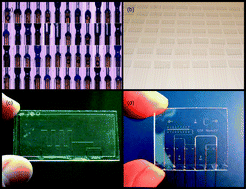A low-cost, manufacturable method for fabricating capillary and optical fiber interconnects for microfluidic devices†‡§
Abstract
Microfluidic chips require connections to larger macroscopic components, such as light sources, light detectors, and reagent reservoirs. In this article, we present novel methods for integrating capillaries, optical fibers, and wires with the channels of microfluidic chips. The method consists of forming planar interconnect channels in microfluidic chips and inserting capillaries, optical fibers, or wires into these channels. UV light is manually directed onto the ends of the interconnects using a microscope. UV-curable glue is then allowed to wick to the end of the capillaries, fibers, or wires, where it is cured to form rigid, liquid-tight connections. In a variant of this technique, used with light-guiding capillaries and optical fibers, the UV light is directed into the capillaries or fibers, and the UV-glue is cured by the cone of light emerging from the end of each capillary or fiber. This technique is fully self-aligned, greatly improves both the quality and the manufacturability of the interconnects, and has the potential to enable the fabrication of interconnects in a fully automated fashion. Using these methods, including a semi-automated implementation of the second technique, over 10,000 interconnects have been formed in almost 2000 microfluidic chips made of a variety of rigid materials. The resulting interconnects withstand pressures up to at least 800psi, have unswept volumes estimated to be less than 10 femtoliters, and have dead volumes defined only by the length of the capillary.


 Please wait while we load your content...
Please wait while we load your content...